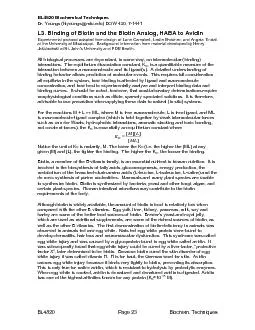/


L32 Competitive Binding Add 2 to 6 ID: 853092
Download Pdf The PPT/PDF document "BL4820 Biochemical Techniques BL4820 Pa..." is the property of its rightful owner. Permission is granted to download and print the materials on this web site for personal, non-commercial use only, and to display it on your personal computer provided you do not modify the materials and that you retain all copyright notices contained in the materials. By downloading content from our website, you accept the terms of this agreement.
1 BL4820 Biochemical Techniques BL4820 Pa
BL4820 Biochemical Techniques BL4820 Page 25 Biochem. Techniques There are several ways to calculate the K. The simplest is to first plot the [HABA]. Also, plot the inverse, 1/ vs. 1/[HABA]. The point where the regression line crosses the x-axis should be roughly equal to the negative inverse of the KA second method involves determining the concentration of the HABA-avidin complex (bound HABA), subtract your AM avidin from the A for reference. To find the concentrations of the complex at each addition, divide this by 34500. (This is the ext
2 inction coefficient of the bound HABA.)
inction coefficient of the bound HABA.) Calculate the free [HABA]: HtotalYou may also try plotting the fraction of ligand bound [HABA]boundoundtotal vs. free ligand [HABA]free. The K is when the molecule pool is half-saturated, Y=0.5. Some example graphs: L3.2 Competitive Binding Add 2 to 6 µl aliquots of 200 cuvette. Mix well after each addition. Observe any changes in color upon addition of biotin. Calculate the [Biotin] from each addition and plot [biotin] vs. A of biotin for avidin by first determining the ICand then calculating the
3 KPrusoff relationship derived from Micha
KPrusoff relationship derived from Michaelis-Menton kinetics. In this case, you are using biotin to compete with HABA for binding sites on avidin thus, HABA is considered the substrate and biotin is considered the inhibitor. Compare the pure avidin sample results with an unknown egg white sample, to determine the avidin concentration. Dilute an egg white 1:1 with HEPES buffer. Place 1 ml in the sample cuvette. Remember to make a reference cuvette. Perform HABA binding as in part 1. Use your calculated K from part 1 to determine the concent
4 ration of avidin. Experiment protocol d
ration of avidin. Experiment protocol done by Lane Campbe BL4820 Biochemical Techniques BL4820 Page 26 Biochem. Techniques L3.2 Sodium Dodecyl Sulfate-Polyacrylamide Gel Electrophoresis (SDS-such as SDS-PAGE use the field only toate (a.k.a. lauryl sulfate) molecules, ein-SDS complex is then separated on a ked with bis-acrylamide. An electric ee than small molecules and thus the gel run faster than large ones. The molecular weight. A plot of the log of the molecular weight vs. relative mobility is then In this experiment you will test whether